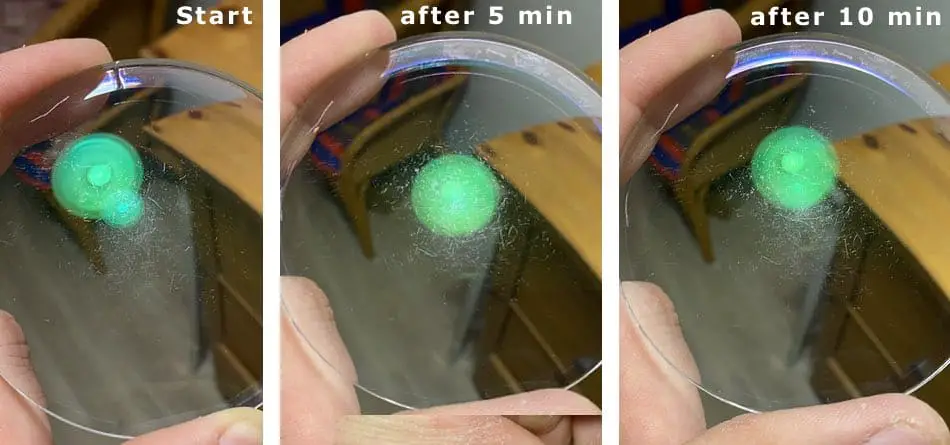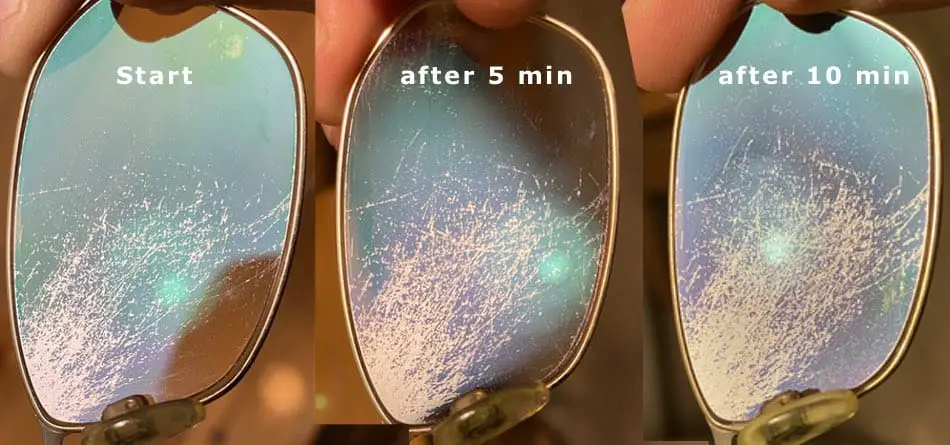It happened to every wearer of glasses. A scratch appears on the surface of your lenses. The question is can you remove the scratches from the glasses? I am a master optician and in this article, I tested various methods for you to get rid of the scratches. You can see the results for every method used in the pictures below.
The methods I used to remove scratches from glasses:
- Baking soda
- Toothpaste
- Wax Based Scratch Fillers
- Glass Etching Products for Removing Scratched Coatings
- Polishing
Before you test those methods on your own glasses you should know the components like the base material or the coating will probably differ from the test situation here in the blog or from a video you see on YouTube that was made in a tutorial style.
Because manufacturers have multiple coatings and base materials. Depending on how deep the scratches are and/or what strain (mechanical or thermal) caused the surface of the lenses to become rough your results may differ from mine in the tests. Therefore I used different coatings but still there is a lot of room for different results here.
Does Baking Soda Really Remove Scratches?
When looking online baking soda gets recommended a lot to remove scratches in your glasses. However, looking at the before and after pictures in the video above, I can see little scratches in both pictures immediately. So can you expect to create a lens surface as your glasses were new? No. But then how good can your glasses be recovered from scratches? Therefore I scratched the surface of the lenses in different intensities.
- Deep scratches (coating is scratched and the underlying lens material)
- Medium scratches that were less visible in the coating
- Tiny scratches from signs of wear
First of all, before I applying toothpaste or baking soda to a lens please pop the lenses out of the frame. The reason, therefore, is the paste and/or the solution with baking soda will accumulate in the space between the lenses and the frame. Depending on the glasses and the frame you can see this debris after you tried to remove the scratches from your glasses. So I highly recommend this article which shows you how to get the lenses out and this one to get the lenses back in.

As I am clearly not the expert for baking sodas I tried to find differences between them and if one type of baking soda might work better for removing scratches from glasses. But after a quick google search apparently, it does not matter what baking soda to choose.
I simply mixed 1-2 teaspoons of baking soda and some water into a thicker solution that will work as a polishing agent. Afterward, I applied the solution onto the lens with a microfiber cloth in circular motions until it completely covered the lenses. Over the period of five minutes, I continued to perform circular motions and made sure not to use too much pressure while cleaning so I did not create more damage than what needed fixing.
As you can see in the results above not much happened after 5 to ten minutes of rubbing the lens with the solution. When having a closer look at the lens the baking soda did scratch the lens a bit more than before.
Toothpaste
Here you can the before and after pictures for toothpaste when I tried to remove the scratches. The process is very straightforward.

All you need is a gentle, non-gel toothpaste. Put some on the scratched area of your glasses and gently rub it in small circular motions with a microfibre for about 5 minutes. Keep rubbing until the scratches are gone is the recommendation you can read on the world wide web.
As you can see in the pictures above there was not much of an effect after rubbing the lens for 5 and 10 minutes. And despite the little polishing effects, the multiple coating layers on your lenses will be damaged when rubbed with toothpaste. Here in this case the coating is broken and starts to peel off.
But although I applied a good amount of pressure to the lens I guess I would need to rub the lenses with the toothpaste for about an hour to get an even surface. So with the front surface and the other lens, this will take up to four hours.
When you watch the video below some effect is shown in removing scratches. But the lens is not coated. In most cases, you will have a coated lens to have an easier time cleaning your glasses and having less glare on the lenses.
So those tips will not apply to you.
Wax Based Scratch Fillers
Wax-based scratch fillers are also oftentimes recommended to smoothen the surface with the wax. But really the results are not good. As soon as the scratch is visible it will be still visible with the wax applied to the lens surface. Despite the wax not having an effect in minimizing the visual cutbacks you experience with scratches the coating’s abilities to reduce streaks on the surface is gone with wax.
During the day you need to clean the lenses only at the places where the wax was not placed on the lens’s surface. This is just not practical for a normal wearer of glasses.
Glass Etching Products for Removing Scratched Coatings
Glass’s etching products are abrasive which means they will definitely also destroy the coating on the lenses. When you polish the lenses with etching products and in combination with a polishing machine you might be able to reduce the visible scratches. But there is a big cutback. The surface of the lens will be slightly changed in terms of the curvature of the lens. What happens is the lens will have a slightly changed lens power after you polished the lens.
So in short you will definitely risk damaging your glasses with a glass etching paste and a polishing machine.
Can You Polish Lenses of Eyeglasses?
Oftentimes when people have scratches in their lenses and want to remove them they ask if they could be polished to get rid of the scratches. As an optician, I can not recommend this. The reason is even when you think you were successful polishing the lenses you will make them slightly opaque. This can be a huge downside when it comes to driving at night. There will be probably a lot of glare.
In the video below a man rubs the lenses with really fine 1200 grid sandpaper. After the scratches got removed there is no way this lens could be used because it is so cloudy. A finer polish needs to be applied to the lens’s surface. In the tutorial below toothpaste and then 3000 grid sandpaper is used to reduce the cloudiness.
But in the end, when he presents the results you can still see a haze on the lens surface which will be very disturbing when using the lens in your glasses. Of course, you could extend the time polishing your lenses but a cloudy lens will not give you good visual results.
I would just save the hour trying to remove the scratches and make an appointment right away at your local optical shop. After trying to remove scratches from your glasses you will need one anyway. When want to try this method despite my advice of not doing it use gloves and polish the lenses in a well-ventilated environment. The reason is many of the positing pastes have aluminum compounds in them which is not the best ingredient to have on your skin or in the air around you.
Conclusion
While it is true that there are methods of fixing eyeglasses, they may not work in your individual case. If the scratch on the lens is deep and stubborn and you try to polish it over a long time then these remedies will only make matters worse. Moreover, any process used could end up making your lenses even more damaged than when you started! I personally cannot recommend any of the mentioned methods to try to remove the scratches from your glasses.
I wish you a great day.
